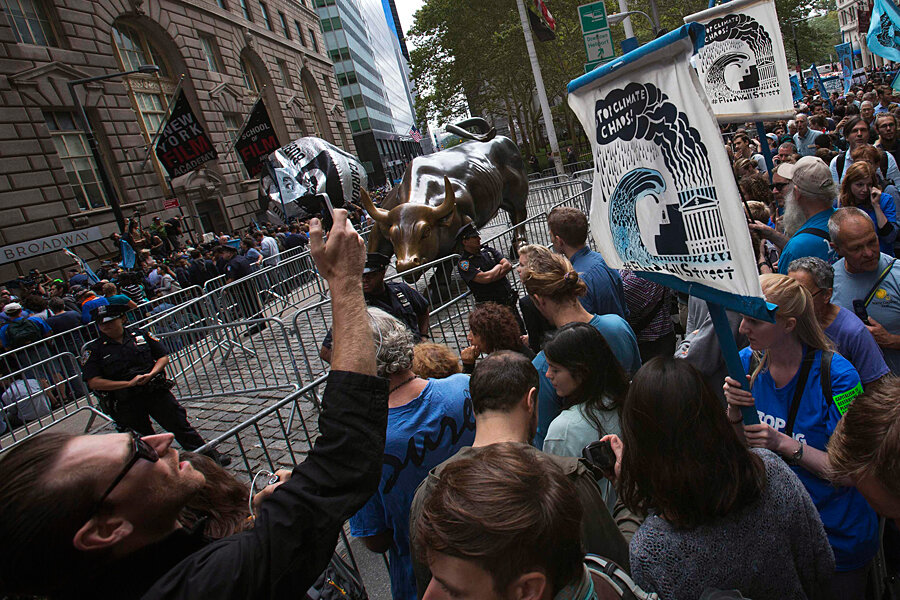Boisterous Flood Wall Street protest: NYPD makes arrests but shows restraint
Loading...
| New York
The New York Police Department took a mostly hands-off approach Monday as thousands of protesters, calling themselves “Flood Wall Street” and chanting slogans against capitalism and climate change, shut down sections of Broadway in the city’s Financial District.
The demonstration, which followed Sunday’s People’s Climate March that drew up to 400,000 protesters from around the globe, was intended to be a more aggressive follow-up to the festive and peaceful march the day before. Organizers billed Flood Wall Street to be a mass sit-in and act of civil disobedience, under the two-sentence slogan: “Stop Capitalism. End the Climate Crisis.”
But although more than 100 protesters were arrested in the evening, the NYPD’s actions throughout the day were measured and uncharacteristically restrained, experts say. The boisterous crowd of more than 1,000, most of whom wore ocean blue to symbolize a flood of water, protested without an official permit from the city as they attempted to approach the New York Stock Exchange.
“I thought it was quite remarkable that the police decided to give people the space to have an extended protest in lower Manhattan,” says Alex Vitale, an associate professor of sociology at Brooklyn College and a frequent critic of the NYPD. “In previous years, especially during the Occupy movement, similar kinds of demonstrations were met with immediate and overwhelming use of force.”
Indeed, the kid-gloves approach to the protesters, many of whom said they were eager to be arrested, was a startling contrast to the actions of the NYPD in 2011, when the administration of former Mayor Michael Bloomberg and Commissioner Raymond Kelly cleared out the Occupy Wall Street sit-ins with well-publicized rough arrests, hair pulling, and rounds of stinging pepper spray.
And in 2007, William Bratton – then commissioner of the Los Angeles Police Department, now that for New York – came under harsh criticism: A series of large protest rallies at MacArthur Park in L.A. degenerated into violence when police officers attacked the crowd with batons and rubber bullets. After a number of scathing reports on the incident, including by a federal judge, Commissioner Bratton apologized and the city paid $13 million in damages.
“So I think what we saw [Monday] was much more in line with international standards of widely accepted best practices,” says Professor Vitale, an expert in urban policing. “These include trying to facilitate protest activity with an eye towards reducing the escalation of conflict, avoiding injuries, avoiding violations of people’s civil rights – and I hope it’s a sign of a long-term shift in policy.”
Since the Flood Wall Street organizers made no secret of their plans for civil disobedience, the city was prepared, blocking some access to the Financial District. So protesters unfurled large banners denouncing capitalism on Broadway, placing them on the street near the district’s iconic Charging Bull bronze statue. They then sat and lay prostrate, blocking traffic for hours.
The crowd also brought giant 20-foot balloons, including a black and silver one that symbolized a CO2 molecule, and bounced them through traffic. The police just watched, but when one of the balloons crossed the barricades, cops pounced and quickly deflated it.
About 3:30 p.m., a group of protesters linked arms, approached the barricades to Wall Street, and attempted to unlink them and push through. For about 15 minutes, protesters and police officers shoved and tugged, and a few officers punched at the hands trying to unlink the gates. Police also finally pulled out their pepper spray to push back the aggressive crowd.
But even then, the officers showed restraint. One person who got through the fence was simply tossed back onto the street. “They could have gotten me 10 times, but they didn't," one unnamed protester told the local news site Gothamist. "They don't want to arrest anybody."
By 7 p.m., however, police told the few hundred remaining protesters to disperse. Many refused, and nearly 100 were arrested in what observers said were slow, deliberate, and methodical arrest procedures.
The Flood Wall Street protest came a day before the city geared up to host world leaders attending the United Nations Climate Summit.
On Tuesday morning, in a speech before the UN’s General Assembly, New York Mayor Bill de Blasio spoke out forcefully against the carbon emissions that are widely believed to contribute to climate change.
“We know humanity is facing an existential threat,” Mr. de Blasio said. “The cause is us: how we heat our homes, how we transport ourselves, the reckless way in which we live. This is an issue we all face – no one is spared – and our mutual need to survive should instill in us a kind of unity we too rarely experience.”
Some observers felt the NYPD’s startling change in tactics against the unsanctioned march and sit-in may have stemmed from de Blasio’s own sympathy with the protesters’ point of view.
“It also could be that the mayor was concerned about negative effects with community relations stemming from the [Eric Garner chokehold] incident," says Vitale, “and was trying to avoid another black eye for the NYPD.”






